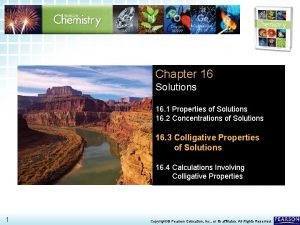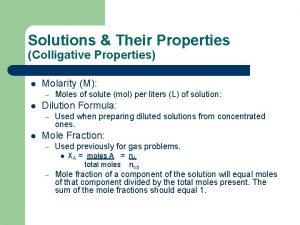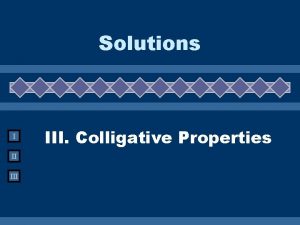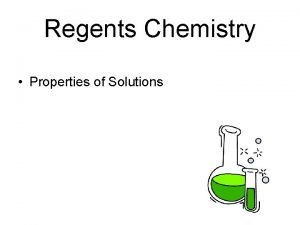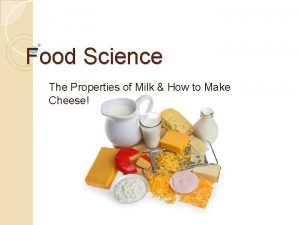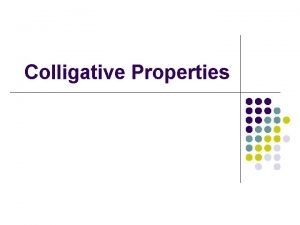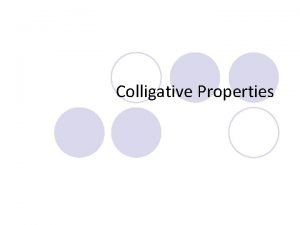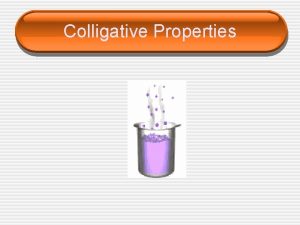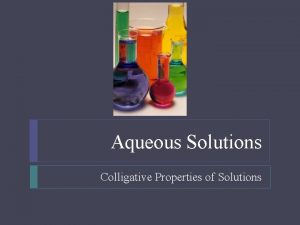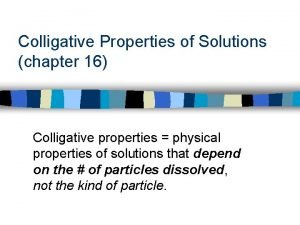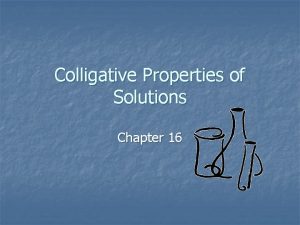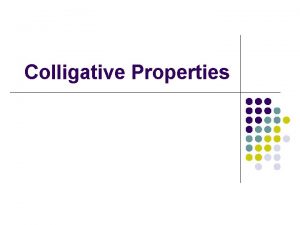Chapter 13 2 Colligative Properties of Solutions St











- Slides: 11

Chapter 13 -2 Colligative Properties of Solutions St. Augustine Preparatory School March 13, 2016

1. Vapor Pressure Lowering • Non-volatile substances have little to no tendency to become a gas under existing conditions. • A non-volatile solute will lower the vapor pressure of the solution having two noticeable effects: – Raising the boiling point of the solution – Lowering the freezing point of the solution • In both cases, more energy is needed than normal to undergo a phase change.

2. Freezing Point Depression • A solution with a nonelectrolyte solute will have a lower freezing point than the pure solvent. • When we dissolve any nonelectrolyte (molecular compound) in water, the freezing point of water will drop ~1. 86°C/m. • Each solvent has its own molal-freezing constant (Kf). Formula: Δtf = Kfm

Freezing Point Depression • So how is freezing point depression defined? • The difference between the freezing points of the pure solvent and a solution of a nonelectrolyte in that solvent, and its directly proportional to the molal concentration of the solution. – If we double the molal concentration, the freezing -point depression will be doubled.

Reminder • Molality: moles of solute divided by kilograms of solvent

Example • What is the freezing-point depression of water in a solution of 17. 1 g of sucrose (C 12 H 22 O 11), in 200. g of water? What is the actual freezing point of the solution?

Example • A solution contains 117 g of sucrose (C 12 H 22 O 11) in 1300. g of acetic acid (CH 3 COOHaq). Acetic acid has a normal freezing point of 16. 6°C and a freezing point constant of -3. 90°C/m. What is the freezing point depression of the solution? What is the new freezing point of the solution?

3. Boiling Point Elevation • A solution with a nonelectrolyte solute will have a higher boiling point than the pure solvent. • A liquid will boil when the vapor pressure of the liquid is equal to the atmospheric pressure. • When we add a nonvolatile substance (one that has little tendency to become a gas under the current conditions), we decrease the vapor pressure of the solution. • This means more energy is needed to boil the solution.

Boiling Point Elevation • The boiling-point elevation of a 1 -molal solution of any nonelectrolyte solute in water has been found by experiment to be 0. 51°C. • Thus, the molal boiling point constant for water is 0. 51°C/m. Formula: Δtb = Kbm

Example • What is the boiling point elevation of a solution made from 20. 1 g of a nonelectrolyte solute and 400. 0 g of water. The molar mass of the solute is 62. 0 g/mol.

Practice Problems You will need info from Fig 2. 3 on pg 424 1. A solution contains 45. g of sucrose, C 12 H 22 O 11, a nonelectrolyte, dissolved in 450. g of camphor. What is the boiling point elevation of the solution? What is the new boiling point? What state is this solution at room temperature? 2. In a laboratory experiment, the freezing point of an aqueous (dissolved in water) solution of glucose is found to be – 0. 325°C. What is the molal concentration of the solution?
 Freezing point chapter 13
Freezing point chapter 13 What are the three colligative properties
What are the three colligative properties Propriété colligative
Propriété colligative 4 colligative properties
4 colligative properties Is molarity a colligative property
Is molarity a colligative property Colligative property definition
Colligative property definition Colligative properties definition
Colligative properties definition Solutions chemistry regents questions
Solutions chemistry regents questions Colligative properties of milk
Colligative properties of milk What are the applications of colligative properties
What are the applications of colligative properties Colligative properties worksheet
Colligative properties worksheet Properties of l
Properties of l

